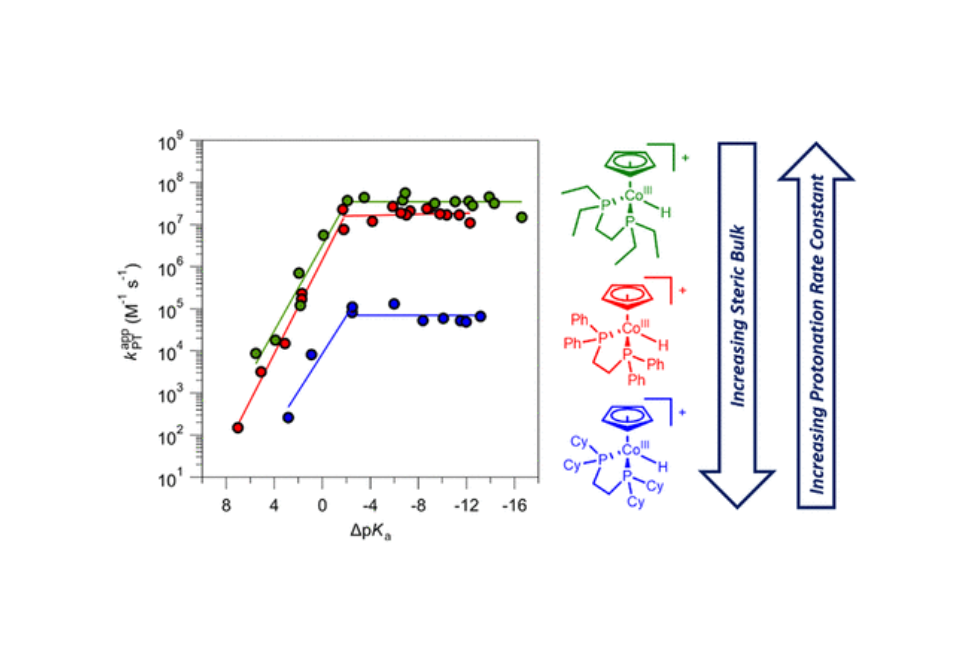Redox-Induced Structural Reorganization Dictates Kinetics of Cobalt(III) Hydride Formation via Proton-Coupled Electron Transfer
Abstract
Two-electron, one-proton reactions of a family of [CoCp(dxpe)(NCCH3)]2+ complexes (Cp = cyclopentadienyl, dxpe = 1,2-bis(di(aryl/alkyl)phosphino)ethane) form the corresponding hydride species [HCoCp(dxpe)]+ (dxpe = dppe (1,2-bis(diphenylphosphino)ethane), depe (1,2-bis(diethylphosphino)ethane), and dcpe (1,2-bis(dicyclohexylphosphino)ethane)) through a stepwise proton-coupled electron transfer process. For three [CoCp(dxpe)(NCCH3)]2+ complexes, peak shift analysis was employed to quantify apparent proton transfer rate constants from cyclic voltammograms recorded with acids ranging 22 pKa units. The apparent proton transfer rate constants correlate with the strength of the proton source for weak acids, but these apparent proton transfer rate constants curiously plateau (kpl) as the reaction becomes increasingly exergonic. The absolute apparent proton transfer rate constants across both these regions correlate with the steric bulk of the chelating diphosphine ligand, with bulkier ligands leading to slower kinetics (kplateau,depe = 3.5 × 107 M–1 s–1, kplateau,dppe = 1.7 × 107 M–1 s–1, kplateau,dcpe = 7.1 × 104 M–1 s–1). Mechanistic studies were conducted to identify the cause of the aberrant kPTapp–ΔpKa trends. When deuterated acids are employed, deuterium incorporation in the Cp ring is observed, indicating protonation of the CoCp(dxpe) species to form the corresponding hydride proceeds via initial ligand protonation. Digital simulations of cyclic voltammograms show ligand loss accompanying initial reduction gates subsequent PCET activity at higher driving forces. Together, these experiments reveal the details of the reaction mechanism: reduction of the Co(III) species is followed by dissociation of the bound acetonitrile ligand, subsequent reduction of the unligated Co(II) species to form a Co(I) species is followed by protonation, which occurs at the Cp ring, followed by tautomerization to generate the stable Co(III)-hydride product [HCoCp(dxpe)]+. Analysis as a function of chelating disphosphine ligand, solvent, and acid strength reveals that the ligand dissociation equilibrium is directly influenced by the steric bulk of the phosphine ligands and gates protonation, giving rise to the plateau of the apparent proton transfer rate constant with strong acids. The complexity of the reaction mechanism underpinning hydride formation, encompassing dynamic behavior of the entire ligand set, highlights the critical need to understand elementary reaction steps in proton-coupled electron transfer reactions.
Citation
Redox-Induced Structural Reorganization Dictates Kinetics of Cobalt(III) Hydride Formation via Proton-Coupled Electron Transfer
Daniel A. Kurtz, Debanjan Dhar, Noémie Elgrishi, Banu Kandemir, Sean F. McWilliams, William C. Howland, Chun-Hsing Chen, and Jillian L. Dempsey
Journal of the American Chemical Society 2021 143 (9), 3393-3406
DOI: 10.1021/jacs.0c11992


